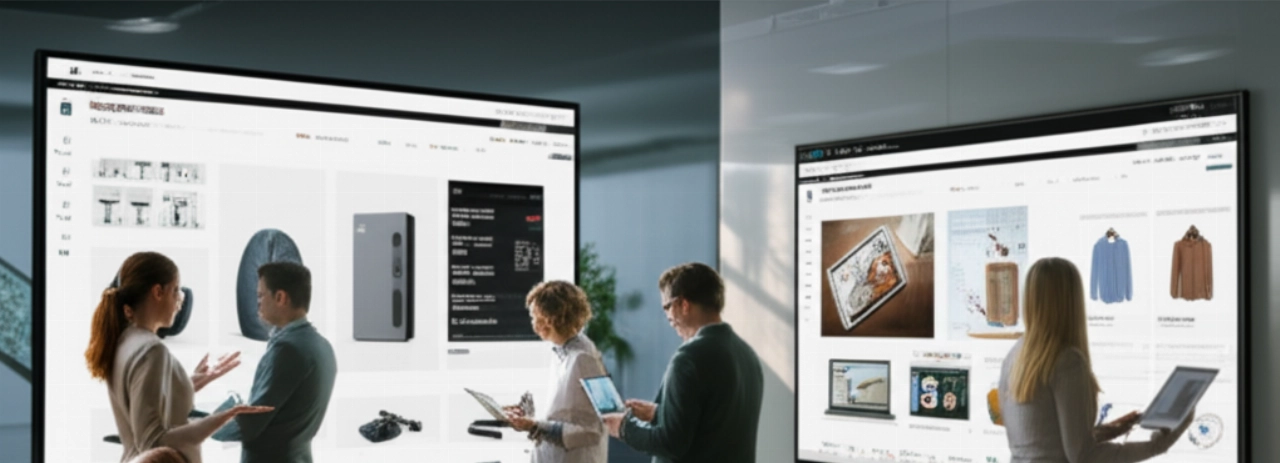Is your SAP Business One installation the powerful engine of your business, yet your e-commerce platform feels like a separate, manual gearbox? You're not alone. For many B2B and enterprise leaders, the promise of digital commerce is often overshadowed by the operational nightmare of disconnected systems. Manual data entry, delayed order processing, inaccurate inventory, and a fragmented customer view are not just inefficiencies; they are direct threats to your scalability and profitability.
At Commerce-K, we understand this chasm. We don't just connect systems; we engineer a unified commerce ecosystem where your SAP Business One data fuels every customer interaction, driving unprecedented efficiency and growth. This isn't merely about a SAP Business One ecommerce integration; it's about achieving Unified Commerce Intelligence – a state where every part of your business operates from a single, accurate source of truth, empowering strategic decisions and delivering a superior customer experience.
This guide will illuminate the path to transforming your digital commerce from a series of isolated silos into a cohesive, high-performance engine. We will show you how to leverage a strategic integration to eliminate technical debt, overcome platform limitations, and finally unlock the true potential of your enterprise B2B operations.

Beyond the Connector: How SAP Business One Ecommerce Integration Transforms Your Entire Business
Many view integration as a purely technical task – a bridge between two software applications. But for enterprise B2B, a robust SAP Business One ecommerce integration is far more than a simple connector; it's the strategic backbone of your entire digital transformation. It's about creating a single source of truth that permeates every aspect of your business, from sales and marketing to fulfillment and finance.
Imagine a world where:
- Real-Time Inventory Accuracy: Your e-commerce site always reflects precise stock levels, directly pulled from SAP Business One, eliminating overselling and backorder headaches.
- Automated Order Processing: Orders placed online flow seamlessly into SAP, triggering fulfillment, invoicing, and shipping processes without manual intervention, drastically reducing processing times and errors.
- Personalized Customer Experiences: Customer-specific pricing, credit limits, order history, and custom catalogs (all managed in SAP) are instantly available on your e-commerce portal, creating a highly personalized and efficient buying experience.
- Streamlined Financial Operations: Sales data, tax calculations, and payment information are automatically reconciled in SAP, simplifying accounting and reducing audit complexities.
- Enhanced Data Synchronization: Product information (PIM), customer data (CRM), and order details are consistently updated across all systems, ensuring everyone in your organization operates with the most current information.
This level of data synchronization and automation doesn't just save time; it reduces your Total Cost of Ownership (TCO) by minimizing manual labor, preventing costly errors, and accelerating your order-to-cash cycle. It transforms your e-commerce platform from a mere storefront into a powerful extension of your ERP, driving efficiency and competitive advantage.

The Hidden Costs of Disconnected Systems: Why 'Good Enough' Integration Is Never Enough
The allure of quick fixes or "off-the-shelf" integrations can be strong, especially when facing the daunting prospect of a complex enterprise project. However, the true cost of a fragmented approach to SAP Business One ecommerce integration is often hidden, manifesting as the very pain points that plague growing businesses:
- The Scalability Ceiling: Your current setup might handle today's volume, but what happens when traffic spikes or your product catalog explodes? Without deep integration, manual processes become bottlenecks, and your platform buckles under the weight of growth, leading to lost sales and frustrated customers. This is the dread of hitting your scalability ceiling.
- Integration Hell: Relying on manual data transfers, CSV uploads, or brittle, custom scripts creates an operational nightmare. Disconnected ERP, PIM, CRM, and WMS systems lead to data chaos, inconsistencies, and a constant drain on resources. This isn't just inefficient; it's a breeding ground for errors that impact customer satisfaction and financial accuracy.
- The Performance Bottleneck: A slow site kills conversions. If your e-commerce platform struggles to pull real-time data from SAP Business One, or if it's burdened by inefficient data calls, every millisecond of delay translates to lost revenue. During peak sales periods, this anxiety becomes a full-blown crisis.
- The 'One-Size-Fits-All' Trap: Many SaaS platforms promise simplicity but deliver rigidity. If your B2B business has complex pricing rules, custom product configurators, unique approval workflows, or intricate customer hierarchies, a standard SaaS solution often proves too restrictive, forcing costly workarounds or limiting your ability to serve your customers effectively.
These aren't just minor inconveniences; they are systemic issues that erode profitability, stifle innovation, and prevent your business from achieving its full digital potential. A strategic integration isn't an expense; it's an antidote to these debilitating challenges, built on a robust API-first architecture and designed to eliminate technical debt.

Engineering a Seamless Ecosystem: Key Considerations for Your SAP Business One Ecommerce Project
Achieving true Unified Commerce Intelligence requires more than just technical prowess; it demands a strategic blueprint. Here are the critical pillars we focus on when engineering a seamless SAP Business One ecommerce integration:
- Strategic Platform Selection: The choice of your B2B commerce platform is paramount. It must be robust enough to handle enterprise-level complexity (e.g., Magento Commerce, Adobe Commerce, BigCommerce Enterprise, commercetools) and flexible enough to integrate deeply with SAP Business One. We help you evaluate platforms based on your unique business logic, scalability needs, and long-term vision.
- Comprehensive Data Mapping & Workflow Automation: This is the heart of any successful ERP integration. We meticulously map data flows between SAP Business One and your e-commerce platform – from customer accounts and pricing to inventory, orders, and shipping. Crucially, we identify opportunities for workflow automation, ensuring that once data enters one system, it automatically updates all relevant others, eliminating manual touchpoints.
- API-First Integration Strategy: Modern, future-proof integrations rely on robust APIs. We design and implement secure, scalable API connections that allow real-time communication between SAP Business One and your commerce platform. This approach ensures flexibility, reduces latency, and supports future expansions without costly re-platforming.
- Custom Development for B2B Specifics: Your B2B business isn't generic, and neither should your commerce solution be. We specialize in custom development to build out features that cater to your unique B2B workflows – whether it's complex tiered pricing, multi-buyer accounts, quote management, or custom product configurators – all seamlessly connected to SAP Business One.
- Rigorous Testing & Phased Rollout: The fear of a failed migration is real. Our approach includes extensive testing protocols (unit, integration, user acceptance testing) to ensure data integrity and system stability. We advocate for a phased rollout strategy where appropriate, minimizing disruption and de-risking your investment, ensuring SEO continuity during migration.
This structured approach ensures that your integration isn't just functional, but truly transformative, setting the stage for sustained growth and operational excellence.
Case Study: Unifying a Global Distributor's Operations with SAP Business One and Magento
A leading global distributor, operating across multiple continents, faced significant challenges with their fragmented e-commerce and ERP systems. Their existing online storefront was a basic catalog, disconnected from their core SAP Business One instance. This led to:
- Manual order entry into SAP, causing delays and errors.
- Inaccurate online inventory, leading to customer frustration and backorders.
- Inability to offer customer-specific pricing or credit terms online.
- Lack of real-time sales reporting and customer insights.
Commerce-K partnered with them to implement a comprehensive SAP Business One ecommerce integration with a robust Magento Commerce platform. Our solution involved:
- Developing a custom API layer for real-time bi-directional data flow between SAP Business One and Magento.
- Automating order processing, inventory updates, customer account synchronization (including custom pricing and credit limits), and shipping information.
- Implementing a complex B2B portal with multi-user accounts, quick order functionality, and personalized product catalogs.
The Results: Within six months of launch, the client experienced a 40% reduction in order processing time, a 95% accuracy rate in inventory synchronization, and a significant increase in online B2B sales. The integration eliminated over 80 hours of manual data entry per week, freeing up resources for strategic initiatives. This wasn't just an integration; it was a complete digital transformation that unlocked new levels of efficiency and customer satisfaction.
Commerce-K: Your Partner in Achieving Unified Commerce Intelligence
The difference between a vendor and a partner lies in understanding your strategic objectives, not just your technical requirements. At Commerce-K, we don't just execute a SAP Business One ecommerce integration; we become an extension of your team, dedicated to engineering a commerce ecosystem that delivers measurable ROI and sustainable growth.
Our expertise spans the deepest technical intricacies of ERP integration, complex B2B commerce platforms, and the strategic foresight required for true digital transformation. We pride ourselves on transparent communication, rigorous project management, and a commitment to de-risking your investment. We build solutions that are not only powerful today but are also future-proof, allowing your business to adapt and thrive in an ever-evolving digital landscape.
Frequently Asked Questions about SAP Business One Ecommerce Integration
- What is the typical ROI of a robust SAP Business One ecommerce integration?
- The ROI is significant and multi-faceted. It includes reduced operational costs (less manual data entry, fewer errors), increased sales efficiency, improved customer satisfaction leading to repeat business, better inventory management, and faster order fulfillment. While specific figures vary, clients often see a return on investment within 12-24 months through these combined efficiencies and growth opportunities.
- How complex is the data mapping and synchronization process?
- Data mapping is often the most critical and complex part of any ERP integration. It requires a deep understanding of both your SAP Business One configuration and your chosen e-commerce platform. We employ experienced business analysts and technical architects to meticulously map all relevant data points (products, customers, orders, pricing, inventory, etc.) and define the synchronization logic, ensuring data integrity and consistency across systems.
- What are the risks of a poorly executed integration, and how do you mitigate them?
- Poorly executed integrations can lead to data corruption, operational downtime, inaccurate reporting, and significant financial losses. We mitigate these risks through a structured methodology: comprehensive discovery and planning, detailed data mapping, phased development, rigorous multi-stage testing (unit, integration, UAT), and a robust deployment strategy. Our focus on an API-first approach also ensures greater stability and flexibility.
- Can this integration support complex B2B pricing and customer-specific catalogs?
- Absolutely. A key benefit of integrating SAP Business One with an enterprise-grade B2B e-commerce platform is the ability to leverage SAP's powerful pricing rules, customer groups, and product configurations directly on your online store. We engineer the integration to ensure that customer-specific pricing, tiered discounts, credit limits, and personalized catalogs are accurately reflected and automatically updated for each logged-in B2B buyer.
- How long does a comprehensive integration project typically take?
- Project timelines vary significantly based on the complexity of your SAP Business One setup, the chosen e-commerce platform, the number of data points to integrate, and the level of custom B2B functionality required. A typical comprehensive integration project can range from 6 to 12 months, including discovery, design, development, testing, and deployment. We provide a detailed project roadmap and timeline after our initial discovery phase.
Unlock Your Unified Commerce Potential Today
Stop letting disconnected systems and manual processes hold your enterprise back. The journey to Unified Commerce Intelligence isn't just about technical fixes; it's about strategic growth, operational efficiency, and building a competitive moat in the B2B landscape. Your business deserves a clear digital commerce roadmap that delivers measurable results.
Perhaps you're thinking, "This sounds expensive," or "We don't have the internal resources for such a complex project." We understand these hesitations. That's precisely why our approach focuses on de-risking your investment and maximizing your ROI through meticulous planning and expert execution. This isn't an 'overkill' solution; it's the essential foundation for sustainable enterprise growth.
The first step isn't a quote; it's a no-obligation Discovery Session with our senior architects and SAP Business One integration specialists. We'll help you assess your current landscape, map your potential, and outline a clear path to a truly unified commerce ecosystem. Click here, tell us about your project, and discover the opportunities you're currently missing. Start building your future-proof commerce engine today.
Further Reading:





